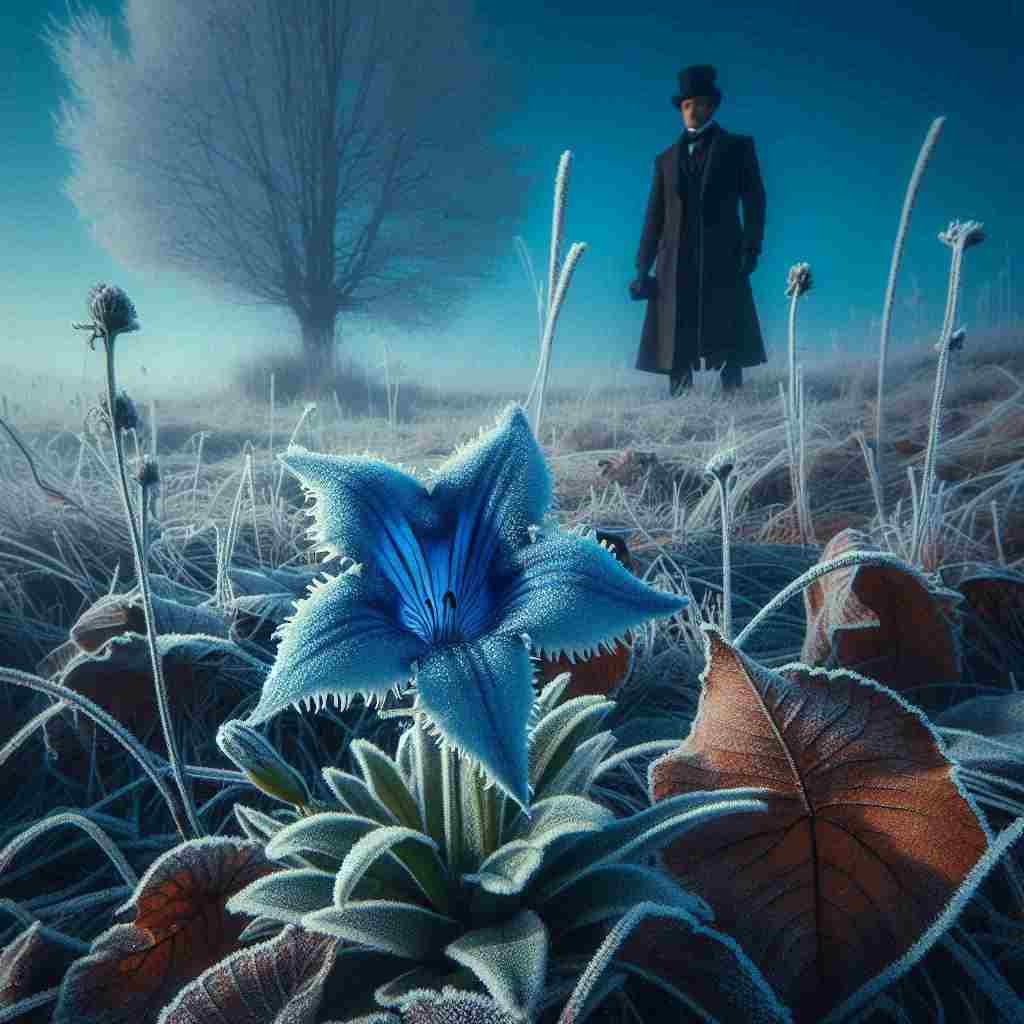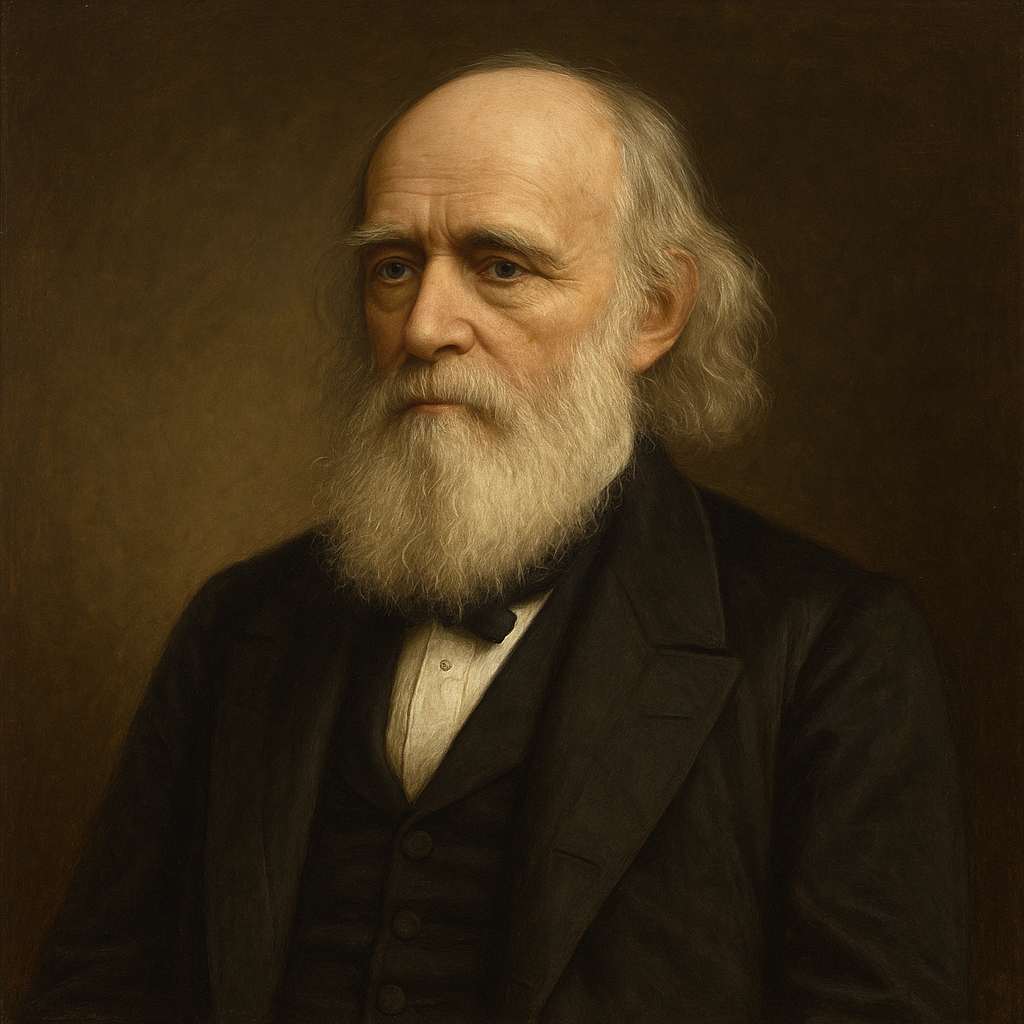To the Fringed Gentian
William Cullen Bryant
1794 to 1878

Want to track your favorites? Reopen or create a unique username. No personal details are required!
Thou blossom bright with autumn dew,
And colored with the heaven’s own blue,
That openest when the quiet light
Succeeds the keen and frosty night.
Thou comest not when violets lean
O’er wandering brooks and springs unseen,
Or columbines, in purple dressed,
Nod o’er the ground-bird’s hidden nest.
Thou waitest late and com’st alone,
When woods are bare and birds are flown,
And frosts and shortening days portend
The aged year is near his end.
Then doth thy sweet and quiet eye
Look through its fringes to the sky,
Blue-blue-as if that sky let fall
A flower from its cerulean wall.
I would that thus, when I shall see
The hour of death draw near to me,
Hope, blossoming within my heart,
May look to heaven as I depart.
William Cullen Bryant's To the Fringed Gentian
Introduction
William Cullen Bryant's "To the Fringed Gentian" is a masterful exemplar of 19th-century American nature poetry, blending Romantic sensibilities with acute observation of the natural world. This 20-line poem, published in 1829, showcases Bryant's ability to infuse seemingly simple botanical descriptions with profound philosophical and spiritual reflections. Through its lyrical exploration of the fringed gentian flower, the poem delves into themes of mortality, resilience, and the human longing for transcendence. This analysis will examine the poem's structure, imagery, and thematic content, revealing the complex interplay between natural observation and metaphysical contemplation that characterizes Bryant's work.
Structure and Form
Bryant employs a consistent rhyme scheme of AABB throughout the poem, creating a sense of harmony and continuity that mirrors the cyclical nature of seasons depicted in the text. The poem is composed of five quatrains, each presenting a distinct aspect of the fringed gentian's existence or its symbolic significance. This structural choice allows Bryant to gradually build his metaphor, moving from concrete description to abstract reflection.
The meter of the poem is predominantly iambic tetrameter, a common choice in English-language poetry that lends itself well to the natural cadences of speech. However, Bryant occasionally varies this pattern, particularly in the first and third lines of each stanza, where he sometimes begins with a trochaic foot. This subtle metrical variation serves to emphasize key words and concepts, drawing the reader's attention to pivotal moments in the poem's progression.
Imagery and Symbolism
The poem's central image, the fringed gentian, serves as a multifaceted symbol throughout the text. Bryant begins by establishing the flower's physical attributes, describing it as "bright with autumn dew" and "colored with the heaven's own blue." This initial description not only paints a vivid picture of the flower but also immediately connects it to the celestial realm, foreshadowing the poem's eventual turn towards spiritual contemplation.
The timing of the gentian's bloom is crucial to its symbolic function. Bryant contrasts it with spring flowers like violets and columbines, emphasizing that the gentian "waitest late and com'st alone, / When woods are bare and birds are flown." This late arrival positions the gentian as a symbol of resilience and hope in the face of approaching winter—a metaphor for mortality that becomes explicit in the poem's final stanza.
The repeated emphasis on the color blue serves multiple purposes. It not only describes the flower accurately but also reinforces the connection between earth and sky, the terrestrial and the celestial. The line "Blue-blue-as if that sky let fall / A flower from its cerulean wall" beautifully encapsulates this idea, suggesting a continuity between the heavens and the earth embodied in the gentian's hue.
Themes and Philosophical Underpinnings
At its core, "To the Fringed Gentian" is a meditation on mortality and the human desire for spiritual transcendence. The poem's progression from autumn to the "aged year... near his end" mirrors the human life cycle, with the gentian serving as a metaphor for hope and resilience in the face of life's inevitable conclusion.
Bryant's Romantic influences are evident in his treatment of nature as a source of spiritual insight and comfort. The gentian is not merely a beautiful flower but a teacher, demonstrating how to face life's end with grace and optimism. This personification of nature as a guide for human behavior is characteristic of Romantic poetry, reflecting a belief in the inherent wisdom of the natural world.
The poem also touches on themes of solitude and individuality. The gentian blooms alone, after other flowers have faded, suggesting that there is value and beauty in standing apart from the crowd. This celebration of uniqueness and untimely blooming could be read as a commentary on the role of the artist or thinker in society, persisting in creativity even when the cultural climate seems inhospitable.
Literary and Historical Context
To fully appreciate "To the Fringed Gentian," it is essential to consider its place within the broader context of American literature in the early 19th century. Bryant was writing during a period of growing national identity and increasing interest in distinctly American themes and landscapes. His focus on native flora and the American wilderness contributed to the development of a national literary tradition distinct from European models.
The poem's blend of natural observation and spiritual reflection also places it within the tradition of American Transcendentalism, which was gaining prominence during Bryant's lifetime. While Bryant is not typically classified as a Transcendentalist, his work shares with that movement a reverence for nature and a belief in its capacity to reveal spiritual truths.
Furthermore, the poem's contemplation of mortality and hope in the face of death reflects the religious and philosophical currents of Bryant's time. The early 19th century saw a resurgence of religious fervor in the United States, known as the Second Great Awakening, which emphasized personal spiritual experience and the possibility of salvation. While "To the Fringed Gentian" is not explicitly religious, its hopeful approach to death resonates with these cultural trends.
Linguistic Analysis
Bryant's diction throughout the poem is carefully chosen to create a tone that is both reverent and intimate. The use of the archaic second-person singular "Thou" to address the flower elevates it to a position of respect, almost as if the poet were addressing a deity. At the same time, the descriptive language remains accessible and grounded in concrete observation, creating a balance between the mundane and the sublime.
The poem's syntax is generally straightforward, with few complex constructions. This clarity of expression allows Bryant to convey profound ideas without obscuring them in overly ornate language. However, he does employ some notable syntactic choices, such as the inversion in "Thou waitest late and com'st alone," which emphasizes the gentian's solitary nature and late arrival.
Conclusion
"To the Fringed Gentian" stands as a testament to William Cullen Bryant's skill as a poet and his deep engagement with the natural world and metaphysical questions. Through its careful observation of a single flower, the poem opens up expansive reflections on life, death, and the human spirit. Bryant's ability to seamlessly blend descriptive nature poetry with philosophical inquiry creates a work that is at once grounded in the particular and reaching towards the universal.
The enduring appeal of this poem lies in its ability to offer comfort and inspiration in the face of mortality. By finding in the fringed gentian a model for how to approach life's end with hope and grace, Bryant provides his readers with a powerful metaphor for their own lives. The poem's final image of hope "blossoming within my heart" as death approaches offers a poignant and uplifting conclusion, suggesting that even in our final moments, we may find beauty and connection to something greater than ourselves.
In its fusion of Romantic sensibilities, acute natural observation, and profound philosophical reflection, "To the Fringed Gentian" exemplifies the best of 19th-century American poetry. It continues to resonate with readers today, offering a timeless meditation on the relationship between humanity, nature, and the eternal.
This text was generated by AI and is for reference only. Learn more
Want to join the discussion? Reopen or create a unique username to comment. No personal details required!



Comments
No comments yet. Be the first to comment!